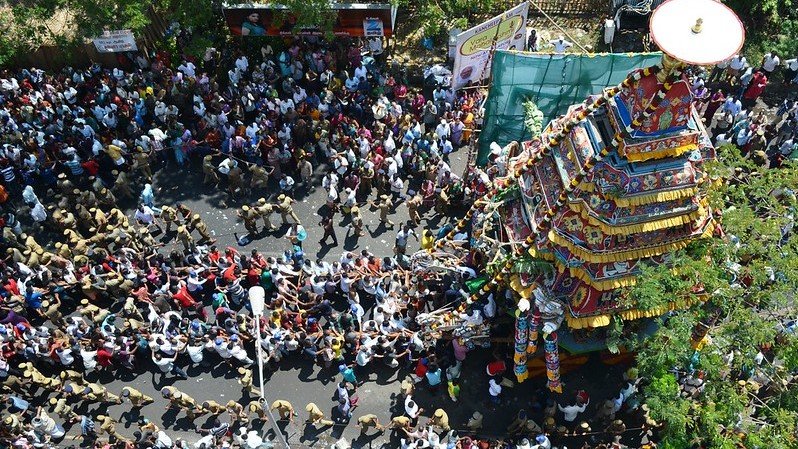Read in : தமிழ்
The terrible disaster of 11 people including three boys dying of electrocution in the Kalimedu accident joins the long list of religious events that kill scores in India annually. The apparent cause of the pre-dawn carnage is a tall cut-out of serial lights tied to the carriage that came into contact with high voltage wires overhead, and resulted in a big blaze. Images of the burnt out traditional car show that it was only a medium-sized rickety carriage upon which the idol of Saivite saint Thirunavukkarasar was placed by the organisers, described as a local prayer club in media reports.
Going beyond the normative statements of shared grief at the Kalimedu accident issued by President Ram Nath Kovind, Prime Minister Narendra Modi, Home Minister Amit Shah, Tamil Nadu Chief Minister M.K. Stalin, State Governor R.N. Ravi and others including Union Ministers, BJP and AIADMK functionaries, financial relief totalling Rs 8 lakh for each of those who died was announced – Rs.5 lakh from the State government, Rs.2 lakh from the PM and Rs.1 lakh from the AIADMK.
Perfunctory statements aside, the pattern of accidents at religious gatherings, notably stampedes and fires, remains unchanged in the country. At an early morning stampede on January 1 this year, 12 people died at Vaishno Devi temple in Katra and the incident drew condolences from the Prime Minister. There was a near-stampede at the Tirumala temple in Tirupati on April 12 over getting free darshan tickets, although luckily it ended with only injuries to three people. One study has found that 79% of stampedes in India occurred at the venues of religious gatherings and pilgrimages. Thanjavur has been the scene of mass casualties at religious events. Fifty people lost their lives in a fire at the famed Big Temple in the town in 1997.
What happened in the Kalimedu accident was far less prominent, by comparison, and the authorities obviously did not take cognizance of the local procession, in spite of the dangerous tall cut-out that was tied to the cart. For a small event, the impact was high. The Tamil Nadu government must hold the local police primarily responsible for the disaster, since any such planned gathering should have come to its notice, and some accountability must also be fixed on the electricity authorities for failing to suspend power during the event.
The Tamil Nadu government must hold the local police primarily responsible for the disaster, since any such planned gathering should have come to its notice, and some accountability must also be fixed on the electricity authorities for failing to suspend power during the event.
A more fundamental question before the State government is whether it has evolved a good risk reduction framework, given the distinct risks surrounding mass gatherings at religious sites. For instance, the National Crime Records Bureau lists 4,309 deaths and 13,612 injuries from road accidents “near a religious place” in pre-COVID 2019. This calls for a focus on road safety around religious shrines.
Successive governments and official agencies including the police are benign towards religious encroachments and local festivals that bring people into conflict with electricity infrastructure.
In addition, there are risks of stampede, fire and drowning. In parallel, Tamil Nadu’s highly urbanised landscape is becoming more and more population-dense, raising risks in urban locations. Yet, successive governments and official agencies including the police are benign towards religious encroachments and local festivals that bring people into conflict with electricity infrastructure. They even tacitly permit theft of electricity to illuminate cutouts at streetside religious structures. Such populism has a dangerous side to it, as many accidents demonstrate.
The Supreme Court and High Courts have repeatedly castigated governments for their indulgent attitude towards religious encroachments. In a 2016 observation, the apex court called such illegal structures “an insult to God.” Yet, political parties see greater virtue in allowing public spaces to be encroached. Such laissez faire governance results in unregulated shows of religiosity, often accompanied by deadly consequences.
What happened in Thanjavur should persuade the Tamil Nadu government to prioritise public safety over populism, and ensure that all religious gatherings are allowed only if they conform to a scientific risk reduction protocol that the official agencies are compelled to follow.
Read in : தமிழ்











